A lecturer plays a crucial role in higher education by delivering engaging lectures that facilitate deep understanding of complex subjects. Their expertise and communication skills help you grasp key concepts and inspire academic growth. Explore the rest of the article to discover effective teaching methods used by successful lecturers.
Table of Comparison
| Aspect | Lecturer | Adjunct Instructor |
|---|---|---|
| Employment Type | Full-time or part-time faculty member | Part-time, contract-based faculty |
| Job Security | More stable, often multi-year contracts | Less stable, usually semester-by-semester appointments |
| Teaching Load | Higher course load, possibly administrative tasks | Limited course load, focused on teaching only |
| Compensation | Salary with benefits | Payment per course, no benefits |
| Institutional Role | Involvement in curriculum development and committees | Primarily focused on classroom instruction |
| Qualifications | Often requires advanced degrees and teaching experience | Varies, may include professionals with practical expertise |
Understanding the Roles: Lecturer vs Adjunct Instructor
Lecturers typically hold full-time positions with responsibilities that include curriculum development, student assessment, and regular office hours, offering greater job stability and institutional involvement. Adjunct instructors, often part-time employees, focus primarily on teaching specific courses without extensive duties beyond classroom instruction, leading to less job security and benefits. Understanding these distinctions highlights the varied levels of commitment, responsibility, and institutional integration between lecturers and adjunct instructors.
Educational Qualifications and Requirements
Lecturers typically hold a master's or doctoral degree in their subject area, reflecting advanced academic qualifications necessary for full-time teaching positions at universities. Adjunct instructors often require at least a master's degree, but the qualifications may vary widely depending on the institution and subject, sometimes allowing significant professional experience in lieu of higher academic credentials. Both roles prioritize subject matter expertise, but lecturers generally meet more stringent educational requirements aligned with permanent faculty standards.
Core Responsibilities and Duties
Lecturers primarily focus on delivering comprehensive course content, designing curriculum, assessing student performance, and engaging in academic advising, often within a full-time or long-term contractual framework. Adjunct instructors typically handle part-time teaching assignments, concentrating on delivering specific course modules with limited involvement in curriculum development or academic service duties. Both roles emphasize high-quality instruction, but lecturers usually have broader responsibilities including research, committee participation, and student mentorship.
Full-Time vs Part-Time Status
Lecturers are typically full-time faculty members with ongoing contracts, responsible for delivering multiple courses and participating in departmental duties. Adjunct instructors usually hold part-time positions, hired on a course-by-course basis without long-term employment guarantees. Full-time status of lecturers provides greater job security and benefits, while adjunct instructors often face limited benefits and variable work hours.
Job Security and Contractual Terms
Lecturers often hold longer-term contracts with a higher degree of job security, including possibilities for renewable multi-year agreements and benefits such as health insurance and retirement plans. Adjunct instructors typically work on short-term, semester-by-semester contracts that lack job security and rarely include benefits, leading to more precarious employment conditions. These contractual differences significantly impact professional stability and career progression within academic institutions.
Salary and Benefits Comparison
Lecturers typically receive higher salaries and more comprehensive benefits compared to adjunct instructors, who are often paid per course with limited or no access to health insurance or retirement plans. Salary disparities reflect the full-time status of lecturers versus the part-time, contract-based nature of adjunct positions. Institutions usually offer lecturers pay scales aligned with experience and academic credentials, whereas adjunct instructors face variable compensation with fewer employment protections.
Expectations in Teaching and Research
Lecturers are primarily expected to focus extensively on teaching, often delivering multiple courses per semester and engaging in curriculum development without formal research obligations. Adjunct instructors typically have even more limited responsibilities, usually part-time teaching without research duties or institutional service expectations. Both roles prioritize instructional effectiveness but differ significantly from tenure-track faculty, who balance teaching with active research and scholarly contributions.
Opportunities for Career Advancement
Lecturers typically have more opportunities for career advancement through full-time, renewable contracts that may lead to tenure-track positions, whereas adjunct instructors often face limited progression due to part-time, temporary roles with fewer institutional benefits. Universities increasingly prioritize lecturers for leadership roles in curriculum development and departmental committees, enhancing their professional growth potential. Adjunct instructors may gain experience and network for future full-time roles but generally lack the structured pathways available to lecturers.
Institutional Perspectives and Hiring Trends
Institutions increasingly differentiate Lecturers and Adjunct Instructors based on contract duration, job security, and teaching load, with Lecturers often holding longer-term contracts and greater institutional integration. Hiring trends reveal a growing reliance on Adjunct Instructors for flexible, cost-effective staffing, reflecting budget constraints and shifting enrollment patterns. Emphasis on professional qualifications and contribution to curriculum development distinguishes Lecturers within academic staffing hierarchies.
Choosing the Right Path: Lecturer or Adjunct Instructor
Choosing the right path between Lecturer and Adjunct Instructor depends on your career goals, desired commitment level, and institutional preferences. Lecturers often hold full-time, salaried positions with responsibilities in curriculum development and student advising, offering greater job stability and professional growth opportunities. Adjunct Instructors typically work part-time, teaching specific courses without long-term contracts, providing flexibility but limited benefits and less influence over academic programs.
Lecturer Infographic

 libterm.com
libterm.com